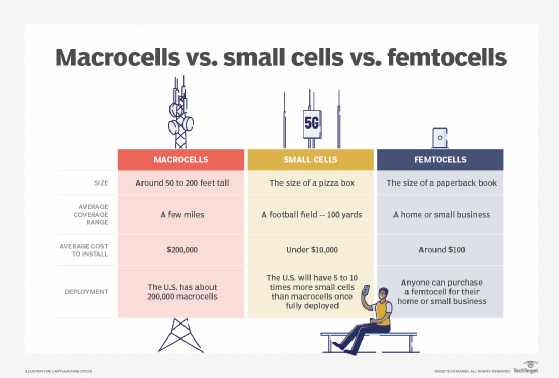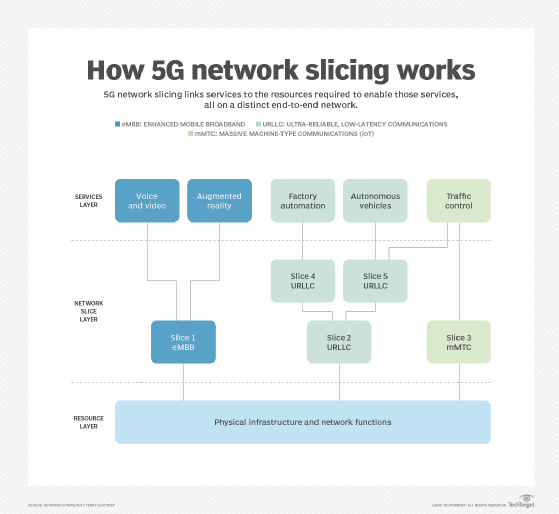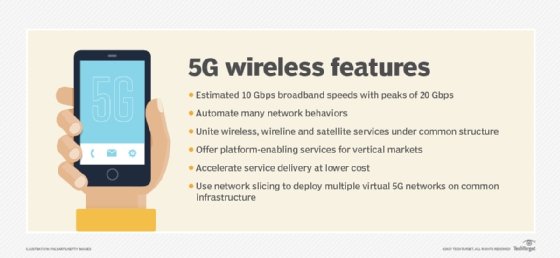small cell
What is a small cell?
A small cell is an umbrella term used to describe a miniature radio access point (AP) or wireless network base station with a low radio frequency (RF) power output, footprint and range. Small cells enhance cellular network coverage and capacity in areas -- such as densely populated city centers -- where use demands are the highest. Going forward, the fifth-generation (5G) small cell is poised to usher in an era of innovation on a massive scale, ensuring significantly improved signal penetration and superior coverage.
How do small cells work?
Operator-controlled small cells can be deployed indoors or outdoors in a licensed, shared or unlicensed spectrum. The device's physical size inspired the name of these miniature base stations.
Small cells look entirely different than macrocells, which are the tall cell towers that people have grown accustomed to seeing on the highway or on top of buildings. Small cells are much smaller -- at about the size of a pizza box.
Because they are small and compact, you can find these low-powered small cell stations installed every few blocks to complement macrocells in densely populated areas. In this scenario, mobile operators running carrier networks usually attach small cells to physical structures, such as the sides of buildings, streetlights and signs. They are essential to the transmission of data to and from wireless devices.
What are small cells in telecom?
To enhance macro communications networks, small cells boost coverage in a specific area by adding targeted capacity. Small cells also support new services and deliver enhanced user experience (UX) by enabling high-speed wireless Broadband and all that entails to be available in more places.
Small cells transfer data using low-, mid- and high-band spectrum. They also use multiple spectral frequencies to boost network bandwidth, increase data transmission and improve speed. However, the range of small cells is limited from 10 meters (m) to 2 kilometers (km).
There are different types of small cells that, depending on the use case, vary in range, form factor and power levels. Mobile operators use only the largest small cell units in urban, outdoor settings and the smallest for indoor settings.
The three types of small cells are the following:
- femtocells. These devices are similar to wireless routers with a typical maximum range of 10 m. Femtocells can only accommodate a few users at a time and are usually deployed indoors.
- Picocells. Boasting a more extensive range of up to 200 m, picocells can support a maximum of 100 users and are typically installed in larger indoor areas, such as hospitals, airports and train stations.
- Microcells. These are the most potent type of small cell and have a range of up to 2 km. Microcells are usually attached to traffic lights and street signs.

What is a small cell in LTE?
Small cells play a critical role in Long-Term Evolution (LTE) networks, as smalls cells are self-organizing and constructed on layers with macrocells. A small cell is connected via the internet to the core mobile network using broadband technology indoors or through the cloud outdoors via a wireless backhaul process. This approach helps maintain optimum coverage and capacity across both fourth-generation (4G) LTE and today's evolving 5G networks.
What is a small cell backhaul?
Small cell Backhaul describes the transmission connections between a mobile network operator's core network and the small cell. This can take the form of almost any broadband internet service, such as fiber, wireless, cable and Digital Subscriber Line (DSL).
Because the performance of the broadband link can potentially affect quality of service (QoS), benchmarking tests are essential to ensuring acceptable transmission rates. In a live operation, the small cells monitor available bandwidth and restrict their own capacity by limiting the number of concurrent calls they handle at time.
Virtualized cells also help mobile operators improve agility and scalability and reduce costs. This approach replaces custom hardware with software that can run on standard computing platforms, enabling wireless carriers to slice their network into smaller pieces -- a process called network slicing, which is a key feature of 5G. To apply virtualization to the radio access network (RAN), the carriers have to split the base station functionally with an xHaul transport interface between the physical and virtual network.

Find out about the pros and cons of network slicing in the context of 5G.
Why is small cell important to 5G?
Like previous generations of cellular networks, 5G will depend on small cells in hyperdense traffic demand areas. 5G small cell technologies also enable scalable, low-cost deployment without the need for highly technical skill sets.
While tall, high-power macrocell towers transmit strong signals across large distances, small cells boost coverage in densely developed environments. This approach helps deliver enhanced end-user experiences by strengthening data transfer speeds and negating the need for devices to compete for bandwidth.
However, it is still early days for 5G small cell technology and unclear how it will be put into practice. While there are technical limitations in small cells, they will be at the heart of 5G hotspots in urban environments.

What are the key benefits of deploying small cells?
Mobile operators and their customers experience a number of benefits from small cells, including the following:
- quick and easy to install;
- can be deployed without highly technical skill sets;
- highly inconspicuous;
- improves coverage;
- boosts capacity in densely populated urban areas;
- cheaper than macrocells;
- highly flexible; and
- extends the battery life of mobile devices.






